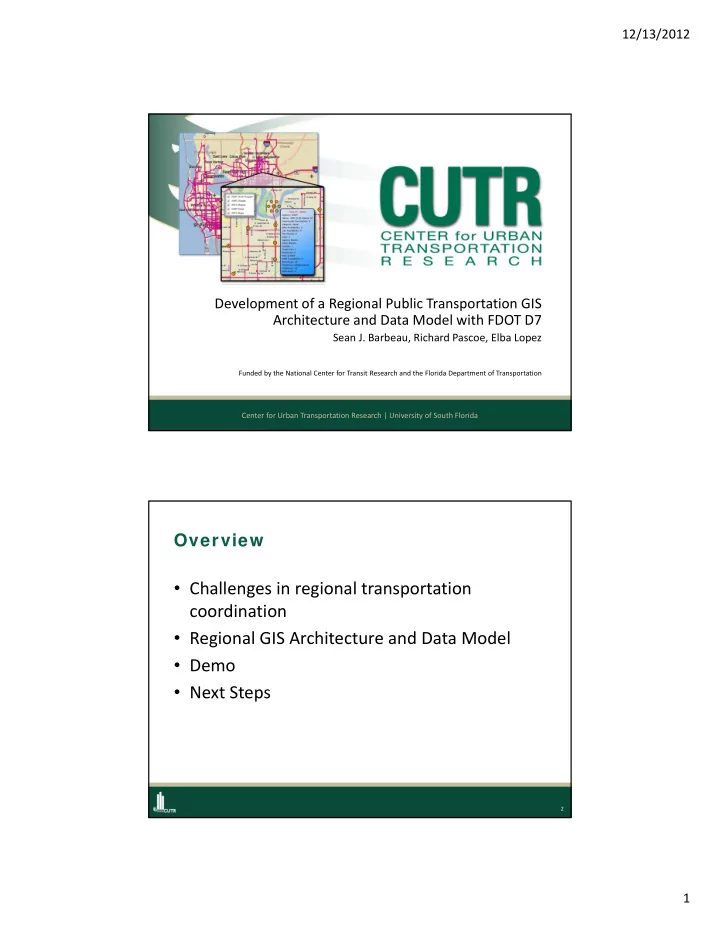

12/13/2012 Development of a Regional Public Transportation GIS Architecture and Data Model with FDOT D7 Sean J. Barbeau, Richard Pascoe, Elba Lopez Funded by the National Center for Transit Research and the Florida Department of Transportation Center for Urban Transportation Research | University of South Florida Overview • Challenges in regional transportation coordination • Regional GIS Architecture and Data Model • Demo • Next Steps 2 1
12/13/2012 I ntroduction • Regional intermodal transportation coordination is important – Planning, construction, and operations of roads can affect transit, and vice versa • Coordination can increase efficiency and cost ‐ effectiveness for overlapping areas of service – E.g., Construction can be coordinated for roads and transit stops 3 Challenges • Regional transportation coordination is difficult – Many jurisdictions with many points of contact – Constantly changing data – Data often stored in different formats – Various levels of technical expertise at different agencies – Time consuming to manually exchange/format/analyze data 4 2
12/13/2012 Regional GI S Architecture and Data Model Project • Concept: – Create a common data format for all transit agencies in a region (i.e., data model) – Create software to automatically retrieve transit data from regional agencies and import into FDOT District 7 geodatabase (i.e., GIS architecture) • Benefits: – Reduce data exchange/formatting efforts – Common web ‐ based view of intermodal data for all agencies 5 Transit Data Update Strategy • Leverage existing General Transit Feed Specification (GTFS) data and process – GTFS used for Google Transit, other apps GTFS data powers Google Transit GTFS data consists of multiple text files and other apps 6 3
12/13/2012 Know n Florida agencies w ith GTFS data • HART – Tampa • PSTA – Clearwater/St. Pete • SCAT ‐ Sarasota • LeeTran – Lee County • SCAT – Space Coast • BCT – Broward • MDT – Miami ‐ Dade • Lynx – Orlando • RTS – Gainesville • Citrus Connection – Lakeland • TriRail – Pompano Beach • Estimated cost for putting data in GTFS format using consultant is $200 ‐ 500 per route 7 Adding new fields to GTFS data • The project working group identified additional data that would be useful beyond existing GTFS data fields – Bus stop amenities – Further route classifications (e.g., local vs. express) – Performance stats (e.g., boardings, alightings per stop) • Agencies add new fields to the GTFS route.txt and stops.txt files. e.g., for stops.txt: stop_id bike_rack sign park_and_ shelter trash_can restroom boardings alightings ride 1645 0 1 0 1 1 0 35.573205 17.61923 8 4
12/13/2012 Regional GI S Architecture CUTR Regional Data Internet/Intranet Users Visualization Web Application HART Server Web Server HTTP Request Agency Data GTFS conversion PSTA Server GTFS file . to spatial data format . . CUTR GTFS Data Sync . Desktop Transit Spatial Database Application Agency FDOT D7 Web Infastructure Servers 9 Process per Agency Schedule Update 1. Transit agency (estimated 30 min to 3 hrs of work) : a) Adds extra fields to their GTFS data, and b) Uploads the google_transit.zip file to the agency’s website 2. FDOT D7 runs the GTFS Data Sync software: 10 5
12/13/2012 Regional Visualization W ebsite 11 Regional Visualization W ebsite FDOT Work Program Data HART Data • Additional details are available when zooming in 12 6
12/13/2012 Regional Visualization W ebsite • Clicking on a bus stop gives additional info in popup 13 Regional Visualization W ebsite • Clicking on a route gives additional info in popup 14 7
12/13/2012 Regional Visualization W ebsite • Clicking on a FDOT D7 work program gives info from D7 database 15 Regional Visualization W ebsite • Can query data via toolbar – e.g., shows all stops with shelters 16 8
12/13/2012 Challenges • Varying skills levels of data analysts at agencies 1. Highly skilled 2. Data analysis is secondary duty 3. Data analysis is outsourced • In our pilot project, HART and PSTA were able to provide full datasets (GTFS + extras) – PCPT didn’t yet have a bus stop inventory or GTFS dataset • Determining when to collect data is a challenge • Potential lack of shape info in GTFS feed – Not required per GTFS spec – Without shape info of bus path, “connect ‐ the ‐ dots” of bus stops is shown as route shape 17 Next Steps • Production deployment of tools at FDOT D7 – Integration of tools into FDOT D7 workflow • FDOT D7 will coordinate with regional transit agencies so the agency uploads their new data with every schedule change • FDOT D7 investigating sharing website publicly so agencies can also view the data • Source code for project is open ‐ source, so any agency or vendor can use/update it: – https://github.com/CUTR ‐ at ‐ USF/RegionalTransitArchitecture/wiki 18 9
12/13/2012 Questions? Sean J. Barbeau, Ph.D. Principal Mobile Software Architect for R&D Center for Urban Transportation Research University of South Florida barbeau@cutr.usf.edu Richard Pascoe GIS Project Manager Grimail Crawford Inc. rpascoe@gc ‐ inc.com Elba Lopez Public Transit/Intermodal Administrator FDOT District 7 Elba.lopez@dot.state.fl.us 19 10
Recommend
More recommend